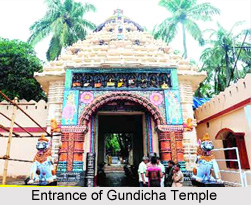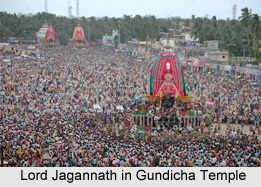 History of Gundicha Temple states the glorious rule of Eastern Ganga Dynasty. Gundicha Temple has many legends and mythological significances. Gundicha Temple is linked with the annual seven-day stay of the central icons of Lord Jagannath and his siblings during the Ratha Yatra Festival of Puri.
History of Gundicha Temple states the glorious rule of Eastern Ganga Dynasty. Gundicha Temple has many legends and mythological significances. Gundicha Temple is linked with the annual seven-day stay of the central icons of Lord Jagannath and his siblings during the Ratha Yatra Festival of Puri.
Queen Of Indradyumna And Lord Jagannath
The queen of Indradyumna after whom the Gundicha Temple is named, has the history of Gundicha Temple. Gundicha Temple had a glance at the divine deity of Lord Jagannath being created by the celestial architect Vishwakarma. Impressed by the deity, the queen of Indradyumna insisted on her husband building the temple for the deity and starting the Ratha Yatra. Another variant suggests that Jagannath was pleased with her temple and promised to visit her house, now the Gundicha Temple.
Mystery of Lord Jagannath
Jagannath is identified with the Lord Krishna. Lord Jagannath goes to stay for seven days in the Gundicha Temple. He intentionally leaves behind his consort Lakshmi locked up in a store room in the main Jagannath temple. While in the Gundicha temple, Lord is exclusively taken care by his "gopis" led by his gopi-lover Radha like Krishna in Vrindavan. The gopis are symbolized by the temple devadasis on this occasion. When Jagannatha returns to his main temple after his amorous dalliance, Lakshmi meets him at the main temple gate and sprinkles some magical powder on him, which makes him forget about his escapade in the Gundicha Temple, and she is immediately reunited with her husband in blissful love.
 Derivation of Gundicha Temple
Derivation of Gundicha Temple
Gundicha is named after the local goddess Gundicha, who is akin to Goddess Durga, worshipped to cure smallpox. Gundi in Oriya means smallpox, which may be derived from the Bengali Guti, which is associated with the smallpox-goddess of neighbouring Bengal - Gutika Thakurani. Gundicha is considered Krishna-Jagannath`s aunt, which he visits with his siblings annually.
Mysterious Disappearance of Chaitanya Mahaprabhu
The mysterious disappearance of Chaitanya Mahaprabhu is revealing the history of Gundicha Temple. He established Gaudiya Vaishnavism and also known to have composed the Jagannath Astakam. He lived in Puri for many years and sang bhajans (devotional songs) and led sankirtan processions in front of Jagannath during his Chandan Yatra and Ratha Yatra, along with many devotees. It is also said that Chaitanya Mahaprabhu used to go into a rapturous mood watching the God"s love play and dance with joy and also fainted many times due to emotion. Daily, he prayed to Jagannath, standing behind the garudastamba (Pillar of Garuda) with tears flowing down his eyes. With permission of the king, Chaitanya Mahaprabhu once undertook the task of cleaning the Gundicha temple premises a day before the Ratha yatra. It is mentioned that once Chaitanya Mahaprabhu, unnoticed by his attendants, walked towards the Gundicha Temple and was last seen entering the Manikotha, thereafter he was never seen again. This disappearance has remained an unexplained mystery as none of the books written on him have recorded this event. It is believed that he merged with Lord Jagannath at the temple.





















